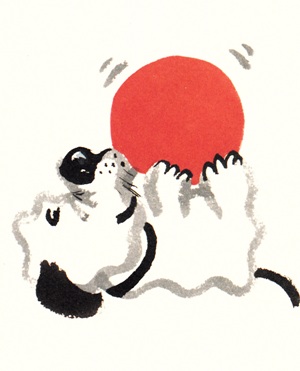
1. BIBLIOGRAPHY
Raschka, Chris. A Ball for Daisy. New York: Schwartz & Wade Books, 2011. ISBN 978-0-375-85861-1
2. PLOT SUMMARY
This is the story of a playful dog named Daisy and her favorite red ball. Daisy joyfully plays with her favorite toy throughout the day and when her owner takes her to the park, the ball goes along. Unfortunately, when play time with a fellow dog ends in disaster, Daisy is devastated. She cries over her burst ball and is saddened at the loss of her favorite playtime toy. That all changes when her owner takes her to the park the next day, and a friend brings a new, blue ball along. Not only does Daisy get to play with it, but she also gets to take it home to replace her old one, and Daisy could not be happier.
3. CRITICAL ANALYSIS
Daisy happy and playful dog who enjoys her ball more than anything. As Daisy's day progresses, readers enjoy following her adventures at the park, until the plot takes a turn and her ball is gone. Daisy's feeling of devastation at the loss of something that is so special to her is relatable to most readers, and they see the way her happy and playful personality turns to that of sadness as she weeps and holds her head down. In the end, readers are excited to find that Daisy's ball has been replaced and she is her happy, playful self once again.
The water color illustrations are vibrant and allow for the pictures to jump out of the pages, which could not be more important in a wordless book. The illustrations are simple and easy to read, allowing readers to follow along and understand where and what is going on with Daisy as they move through the story. Most importantly, through the use of colors, readers are able to see every emotion in Daisy's little face and body language as she goes from happiness to sadness, to joyful once again when her ball is replaced in the end.
4. REVIEW EXCERPT(S)
2012 CALDECOTT MEDAL
New York Times Bestseller
New York Times Best Illustrated Book
From School Library Journal: “Raschka's genius lies in capturing the essence of situations that are deeply felt by children.”
From Horn Book: “a story that is noteworthy for both its artistry and its child appeal.”
From Kirkus Reviews: "Rarely, perhaps never, has so steep an emotional arc been drawn with such utter, winning simplicity."
5. CONNECTIONS
Gather other wordless Caldecott Medal books to read such as:
• Wiesner, David. Tuesday. ISBN 0395870828
• Wiesner, David. Flotsam. ISBN 0618194576
Gather other Chris Raschka books to read such as:
• Daisy Gets Lost. ISBN 0449817415
• Peter and the Wolf. ISBN 0689856520
• Little Black Crow. ISBN 9780689846014
Use as an interactive reading lesson when teaching students the three ways to read a book (read the words, read the pictures/page, re-tell the story).
Use with a beginning of the year unit on feeling and how to deal with emotions in earlier grades
Read This is Not My Hat by Jon Klassen and Mr. Wuffles! by David Wiesner to compare and contrast similarities and differences between animals and their behavior.
• Klassen, Jon. This is Not My Hat. ISBN 076365596
• Wiesner, David. Mr. Wuffles!. ISBN 0618756612
